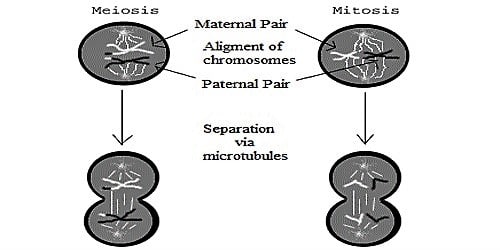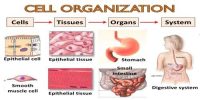Metaphase is the third phase of mitosis, the process that separates duplicated genetic material carried in the nucleus of a parent cell into two identical daughter cells. Metaphase-1 of meioses are the pairs of chromosomes (bivalents) become arranged on the metaphase plate and are attached to the now fully formed meiotic spindle.
The difference is that in Metaphase-1 of meiosis the chromosome put together in two pairwise and therefore cross over takes place at the same time as in mitosis the chromosome organize in particular pair and no cross over takes place. In metaphase 1 the pairs of chromosomes referred to as bivalents are totally condensed. Moreover the in metaphase 1 of meiosis there is no centromere division whereas in metaphase of mitosis it does.
They align on the metaphase plate in between the poles. At this stage of meiosis, the meiotic spindle fibers are completely shaped. One chromosome from a homologous pair is attached to fibers originating from one pole at the same time as the other homologous chromosome attached to fibers from the contradictory pole.
Difference between Metaphase of mitosis and Metaphase-1 of meioses
Metaphase of mitosis
- In mitosis, there is only one division and it produces two daughter cells. Involves one cell division and consequences in two daughter cells.
- In the phase, centromeres of the chromosomes undergo division.
- Centromeres are arranged along the equational plane and Chromosomes do not form any loop.
- The nature of chromosomes remains unchanged as crossing over does not occur.
- It has only one step. In mitosis, homologous chromosomes pair with each other (i.e., they form tetrads) and crossing-over never occur.
- Single chromosomes with two chromatids each, line up on the metaphase plate.
- In metaphase of mitosis, individual chromosomes align there.
- Results in diploid daughter cells (chromosome number remains the same as parent cell) and daughter cells are genetically identical.
- Occurs in all organisms except viruses and creates all body cells (somatic) apart from the germ cells (eggs and sperm)
- Prophase is much shorter and no recombination/crossing over occurs in prophase.
- In metaphase individual chromosomes (pairs of chromatids) line up along the equator.
- During anaphase, the sister chromatids are separated to opposite poles.
 Metaphase-1 of meioses
Metaphase-1 of meioses
- In meiosis there are two successive divisions, ultimately producing four daughter cells. Involves two successive cell divisions and consequences in four daughter cells
- Centromeres of chromosome remain undivided.
- Centromeres remain a little bit any from the equational plane and Chromosomes form loops.
- Crossing over occurs in the substage pachytene and the nature of chromosome remain unchanged
- Metaphase of meiosis has two steps such as metaphase-1 and metaphase-2. In meiosis, homologous chromosomes pair with each other (i.e., they form tetrads) and crossing-over occur.
- Paired chromosomes (bivalents) with four chromatids in each pair line up.
- In metaphase I of meiosis, tetrads align on the metaphase plate.
- Results in haploid daughter cells (chromosome number is halved from the parent cell) and daughter cells are genetically different.
- Occurs only in animals, plants, and fungi and creates germ cells (eggs and sperm) only
- Prophase I takes much longer and involves recombination/crossing over of chromosomes in prophase I
- In metaphase, I pairs of chromosomes line up along the equator.
- During anaphase I the sister chromatids move together to the same pole.
Another important dissimilarity in comparing mitosis versus meiosis is that meiotic prophase I last far longer than does mitotic prophase. In fact, it is broken into numerous named substages, which is not the case for mitotic prophase.














